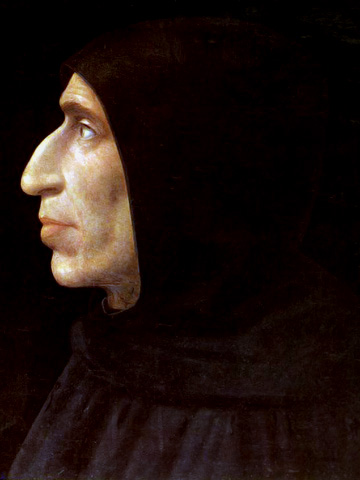 |
| Savonarola |
Rodrigo the Man
Rodrigo was
a hard working churchman who rarely missed a consistory; he was also learned in
the scriptures being;
‘So familiar with Holy Writ,
that his speeches were fairly sparkling with well-chosen texts of the Sacred
Books.’[i]
Although a
religious conservative Rodrigo was nevertheless tolerant of those who held less
orthodox beliefs than his own. He did not take slurs personally, shrugging off
the slanders of those such as Savonarola who claimed that in Rodrigo.
‘The bestiality and savagery
of Nero and Caligula are surpassed.’[ii]
Rodrigo had
a childish love of ceremony and pomp, agreeing that it was a cardinal’s duty to
maintain the dignity of the College of Cardinals and to ensure that Rome was the most
magnificent city in the world.
Rodrigo was
almost unsurpassed in his prodigal display of wealth, but he was almost
abstemious when it came to the food he ate. Guests at his table were presented
with plain fare, so much so that it was not a pleasure to dine with him; indeed
the ambassador from Ferrara described the experience as ‘disagreeable’.
The Election
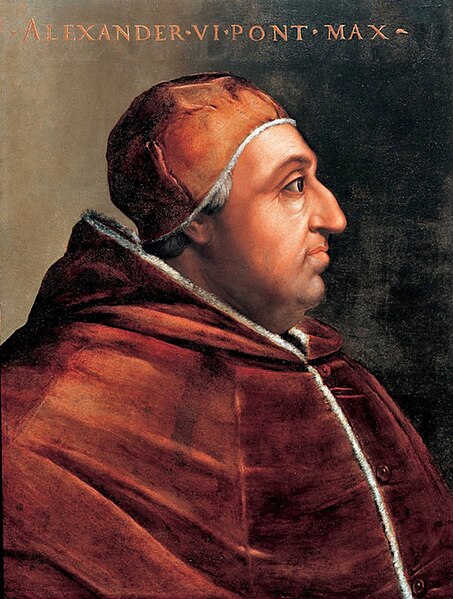 |
| Alexander VI |
Innocent
died in July 1492; his successor was not Giuliano della Rovere, as might have
been expected, but his opponent Rodrigo di Borgia. The historian Francesco Guicciardini claimed of Rodrigo’s election[iii] that;
‘With money, offices,
benefices, promises, and all his power and resources he suborned and bought the
votes of the cardinals and the College.’[iv]
In reality Rodrigo
was a beneficiary of the collapsing power structure in Italy. The moderate
Lorenzo de’ Medici had died in April and his son Piero[v] was no politician. Piero cast the
treaty with the Sforzas of Milan adrift, leaving Ludovico Sforza[vi] searching for new allies.
Giuliano della
Rovere entered the conclave the favoured candidate of Ferrante of Naples and of
Charles VIII of France[vii] who made 200,000 ducats[viii] available for Giuliano’s
expenses, a further 100,000 ducats
were donated by the city of Genoa. He
was also favoured by Venice, not to mention all his cousins. The first ballot,
of the twenty three cardinals in the conclave, found della Rovere with five
votes; his share of the vote did not rise through subsequent ballots, although
Rodrigo’s share did.
 |
| Cardinal Carafa |
The cardinal
leading the ballots, although without sufficient votes to win outright, was
Cardinal Oliviero Carafa with nine votes. His support came
from either side of the political divide; Naples and Milan. The Sforzas refused
to accept della Rovere as pope and he, in his turn, would not accept a puppet
controlled by Milan.
Enter the
compromise candidate; the Spaniard. Sforza decided to back Rodrigo[ix], and the Sforza votes
were added to Rodrigo’s tally, and so eventually did della Rovere, the cardinal
with the money to bribe his fellow cardinals. Ferrante of Naples was most put
out by Rodrigo’s ascension to the throne of St Peter.
A New Beginning
Rodrigo’s
reign as Pope Alexander VI began on 11th August 1492; his election
led the young Cardinal Giovanni de’ Medici[x] to proclaim;
‘Flee, we are in the hands
of a wolf.’[xi]
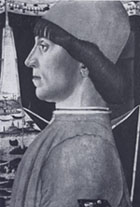 |
| Cardinal Ascanio Sforza |
At the end
of the month Rodrigo held the customary consistory to give away all the
benefices he had collected during his career. Most of the cardinals benefitted;
the young Ascanio Sforza was made Vice-Chancellor in
Rodrigo’s place. The only cardinal created was one Juan di Borgia Lanzol[xii], the first of ten members of the
Borgia family to be so elevated.
Following
the expulsion of the Jews from Spain in the spring of 1492, by Ferdinand and Isabella; some
9,000 impoverished Iberian
Jews arrived at the
borders of the Papal
States in the summer[xiii]. Rodrigo welcomed them
into Rome, declaring that they were;
‘Permitted to lead their
life, free from interference from Christians, to continue in their own rites,
to gain wealth, and to enjoy many other privileges.’[xiv]
Rodrigo also
allowed the immigration of Jews expelled from Portugal in 1497 and from Provence in 1498. Della Rovere, a
man well-known for his lack of tolerance, claimed that Rodrigo was a marrano.
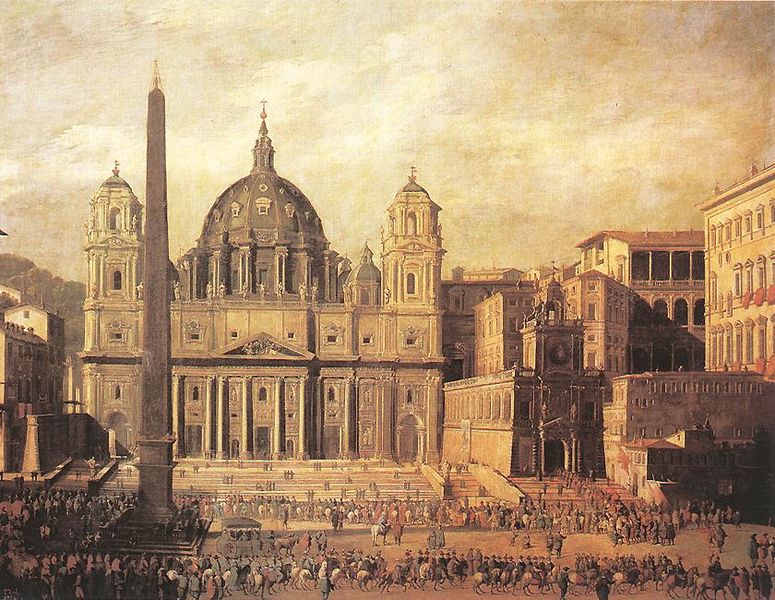 |
| St Peter's Square |
In contrast
to his humanity towards the Jews, Rodrigo celebrated the reverse side of the Alhambra Decree, the expulsion of the Moors from Spain, with a bullfight in
the Piazza San Pietro.
Innocent had
failed to keep law and order in Rome and Rodrigo cracked down; on 3rd
September, less than a month after his elevation, two notorious murderers were
hanged and their houses pulled down. Numerous lesser criminals were housed in
the Castel Sant’Angelo and a new force of watchmen and constables were employed
to keep the peace; twenty one were employed to enforce justice on the bridges
over the Tiber.
Looking after the Family
Cesare was
just 18 when his father became pope; he was to learn firsthand how devoted the
new pope was to his children. Cesare had become a priest at the age of seven,
an indulgence to allow this was given by Sixtus[xv]; he studied at the
universities of Perugia and Pisa and finally the Studium Urbis[xvi] in Rome.
N
ow on 20th
September 1493, much against his wish, Cesare was made a cardinal; what Cesare
wanted was to be a soldier. It took him nearly five years to persuade his
father otherwise. At the same time Giraloma’s brother-in-law Guiliano Cesarini junior[xvii] was also made a cardinal.
 |
| Cardinal Guiliano Cesarini junior |
Three years
after Cesare’s elevation, in 1496, Juan di Borja Lanzol the younger was made a cardinal.
Four years later Pedro Luis di Borja Lanzol was similarly elevated along with Amanieu d’Albret, Cesare’s brother-in-law. Rodrigo’s nephew Francisco di Borja and another relative Juan de Vera were made cardinals six months later on 28th
September 1500. And finally Juan Castellar y di Borja and Francisco Lloris y di Borja were elevated three years later.
In 1493
Lucrezia’s marriage to Giovanni Sforza[xviii] was celebrated with great pomp at
the Vatican.
‘They first served the pope
and the cardinals, then the bride, bridegroom and ladies, whilst others went to
the clergy and the rest, and finally they flung what sweets remained amongst
the people outside, in such abundance that I believe more than a hundred pounds
of sweets were trampled underfoot.’[xix]
Worldly Concerns
 |
| Arms of Duchess of Gandia |
In August
1493 the Spanish, concerned to counter the Sforza alliance, pressed for Juan
Borgia[xx] to come to Spain and
marry his affianced; Maria Enriquez de Luna[xxi], a cousin of King Ferdinand. The
wedding took place the following month.
Concerned
about the succession of the throne of Naples, the aged Ferrante, now 70, was
pressing for closer relations with the Vatican, while the French king[xxii] demanded that Rodrigo
acknowledge his claim to the Neapolitan crown. Charles’ overtures were rebuffed
as Rodrigo was reconciled with two of the leading supporters of Ferrante; della
Rovere and Cardinal Orsini. With their support Rodrigo was able to have Cesare
made a cardinal along with Alessandro Farnese, the brother of Rodrigo’s mistress
Guilia Farnese[xxiii].
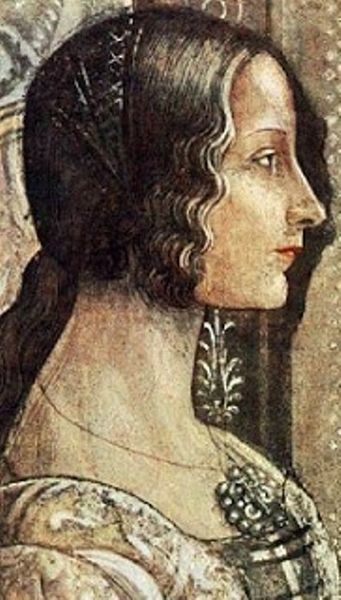 |
| Sancha of Aragon |
Ferrante
died on 25th January 1494 and his throne was claimed by his son Alfonso as well as Charles VIII[xxiv]. Rodrigo supported
Alfonso, but della Rovere changed sides to support Charles. The cardinals in
consistory agreed to support Alfonso and the pope sent his Master of Ceremonies
Johann Burchard to oversee Alfonso’s coronation on 8th May.
‘Once he had been invested
with the staff, His Majesty kissed it and handed it to the Royal Chancellor,
and then sat down on the faldstool[xxv]
opposite the legate [Cardinal Giovanni Borgia] who then commenced the
coronation service.’[xxvi]
The
following day Alfonso made Joffre Borgia the Prince of Squillace[xxvii]. Joffre was married to Sancha of Aragon, Alfonso’s illegitimate daughter, to cement the
alliance between the papacy and the throne of Naples. The couple lived in the
Vatican for most of their married lives. Sancha made friends with Lucrezia and
allegedly, keeping it all the family, had affairs with Juan and Cesare.
Bibliography
At the Court
of the Borgia – Johan Burchard, Folio Society 1990
Italian
Dynasties – Edward Burman, Equation 1989
Lucrezia
Borgia – Rachel Erlanger, Michael Joseph 1979
Florence and
the Medici – JR Hale, Phoenix Press 2001
The Rise and
Fall of the House of Medici – Christopher Hibbert, Folio Society 2001
The Borgias
– Mary Hollingsworth, Quercus Editions 2014
The Borgias
– GJ Meyer, Bantam 2013
A History of
Venice – John Julius Norwich, Penguin Books 1982
Absolute
Monarchs – John Julius Norwich, Random House 2011
A
Renaissance Tapestry – Kate Simon, Harrap 1988
The March of
Folly – Barbara Tuchman, Cardinal 1990
www.wikipedia.en
[ii]
The Borgias - Meyer
[iii]
He was writing of events that happened when he was 9 years old and was viewing
matters with 40 years worth of hindsight
[iv]
The Borgias - Meyer
[v]
Known as the Unfortunate
[vi]
Who was to make himself Duke of Milan in 1495 after the suspicious death of his
nephew Gian Galeazzo
[vii]
Soon to make his mark on Italy
[viii]
In 2013 the relative: historic standard of
living value of that income or
wealth is £132,400,000.00 economic status
value of that income or wealth is £3,572,000,000.00 economic power value of that income or wealth is £52,020,000,000.00 www.measuringworth.com
[ix]
A marriage between one of the Sforza family and Lucrezia was agreed in February
1492
[x]
The second son of Lorenzo de’ Medici was made a cardinal aged 14; he was later
Pope Leo X
[xi]
The March of Folly - Tuchman
[xii]
Juan had been working in Rome for Rodrigo for some years
[xiii]
Many of their fellow religionists were evacuated by Sultan Bayezid II from Spain after
the proclamation of the Alhambra Decree and resettled throughout the Ottoman
Empire.
[xv]
The church did not normally allow the illegitimate to become priests
[xvi]
Now Sapienza University of Rome
[xvii]
Giraloma was married to one of the sons of Gabriele Cesarini Gonfaloniere of the Roman
people and his wife Godina a member of the powerful Colonna family
[xix]
At the Court of the Borgia - Burchard
[xx]
Now Duke of Gandia following the death of Pedro Luis sometime after 1485
[xxi]
Who had previously been engaged to Pedro Luis; the couple had two children
[xxiii]
It is not known when Guilia became Rodrigo’s mistress, but at the very latest by
November 1493
[xxv]
A bishop’s portable folding chair used in church services
[xxvi]
At the Court of the Borgia - Burchard
No comments:
Post a Comment
Note: only a member of this blog may post a comment.